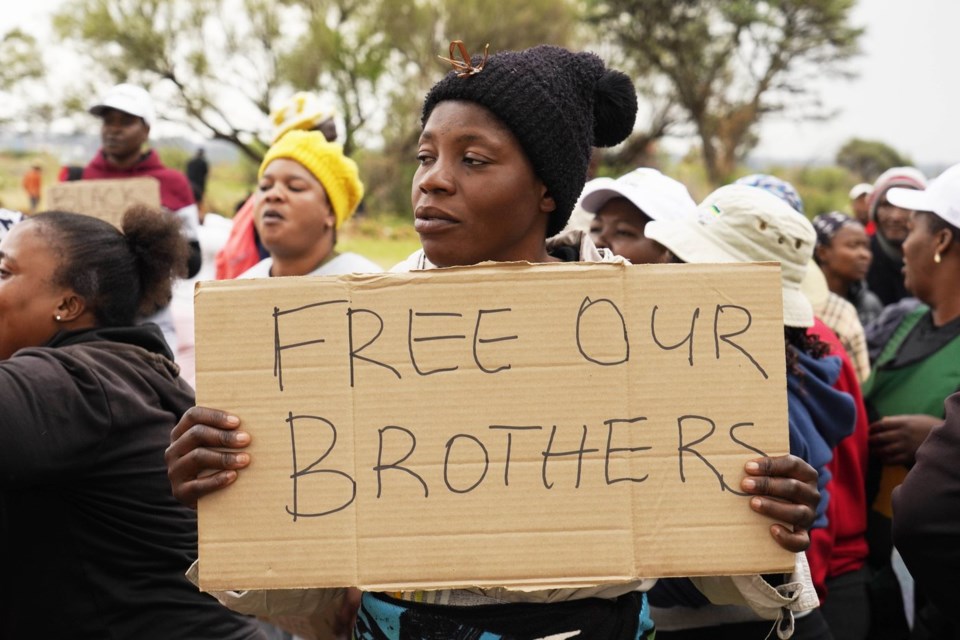JOHANNESBURG (AP) — At least 100 men who were mining illegally in have died of suspected starvation and dehydration after being while police tried to force them out, a group representing the miners said Monday.
More than 500 others are still trapped, the group said.
Sabelo Mnguni, a spokesman for the Mining Affected Communities United in Action Group, told The Associated Press that a cellphone sent to the surface with some rescued miners on Friday had two videos on it showing dozens of bodies underground wrapped in plastic.
Mnguni said “a minimum” of 100 men had died in the mine in North West province where police first launched an operation in November to force the miners out. They were suspected to have starved to death or died of dehydration, Mnguni said. He said 18 bodies have been brought out since Friday.
Nine of those bodies were recovered in a community-led operation on Friday, he said. Another nine were recovered in an official rescue operation by authorities on Monday, when 26 survivors were also brought out, Mnguni said.
Police spokesperson Brig. Sebata Mokgwabone said they were still verifying information on how many bodies had been recovered and how many survivors brought out after starting a new rescue operation on Monday. Authorities now hope to bring all of the miners out, they said.
Illegal mining is common in parts of gold-rich South Africa where companies close down mines that are no longer profitable, leaving groups of informal miners to illegally enter them to try and find leftover deposits.
The mine in question near the town of Stilfontein southwest of Johannesburg has been the scene of a standoff between police and miners since authorities first attempted to get the miners out and seal the mine two months ago. Police said the miners were refusing to come out of the Buffelsfontein Gold Mine for fear of arrest, but Mnguni said they had been left trapped underground after police removed the ropes they used to climb into and out of the mine.
Police also cut off the miners’ food supplies in an attempt to force them out, an action that was fiercely criticized by Mnguni's organization, which is known as MACUA, and others. MACUA won a court case in December that ordered police and provincial authorities to allow food, water and medicine to be sent down to the miners.
The South African government also came under scrutiny last year when it
The cellphone videos purportedly from the depths of the mine and released publicly by Mnguni’s group show dozens of what appear to be dead bodies wrapped in plastic lying in darkened tunnels. A man filming on the phone in one of the videos can be heard saying, “this is hunger. People are dying because of hunger" as he records emaciated-looking men sitting on the damp floor of the mine. He adds: “Please help us. Bring us food or take us out.”
Mnguni said that the more than 500 miners still underground were in different places in the mine, which is one of the deepest in South Africa at 2.5 kilometers (1.5 miles) deep and has multiple shafts, many levels and is a maze of tunnels, he said. He said a preliminary autopsy report on a body that was previously brought out of the mine showed the man had died of starvation.
“What we understand is that there are different groups of miners underground and all of them have miners who have died," Mnguni said. “So, we are estimating that the number of those who have died is very high.”
Large groups of illegal miners often go underground for months to maximize their profits, taking food, water, generators and other equipment with them, but also relying on others in their group on the surface to send down more supplies.
Mnguni said the miners who had previously managed to make it out had sometimes crawled through tunnels for 3-4 days risking their lives to make it to another shaft where they could escape.
Police have said they are uncertain exactly how many illegal miners remain underground, but also say it’s likely to be hundreds.
They said that delegations from the ministry of police and ministry of mineral resources would visit the mine on Tuesday “following the commencement of operations aimed at ensuring that all illegal miners resurface.” The operation to force the miners out of the Buffelsfontein mine that started last year was part of a larger one that resulted in more than 1,500 illegal miners surfacing from mines and being arrested across the North West province, police said.
South African authorities have long tried to crack down on illegal mining gangs, which are known as “zama zamas” — which means "hustlers" in the Zulu language — and have a reputation for being violent, often armed and part of criminal syndicates.
But Mnguni said these particular miners were not criminals but former mine employees who had been put out of work when mines closed and were left desperate.
“The miners go back to the mine because they live in poverty,” he said.
___
Imray reported from Cape Town, South Africa.
Mogomotsi Magome And Gerald Imray, The Associated Press



